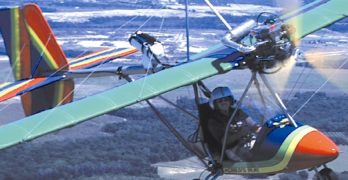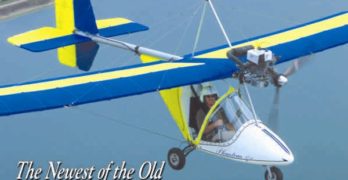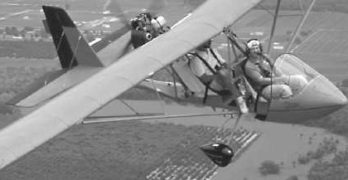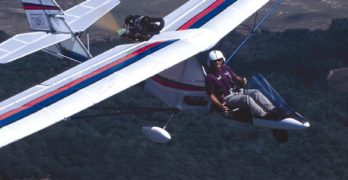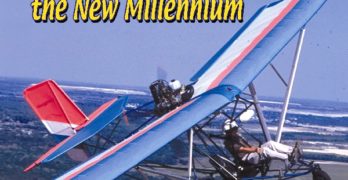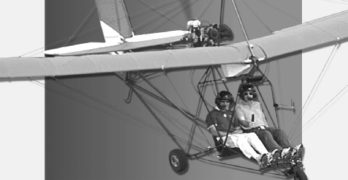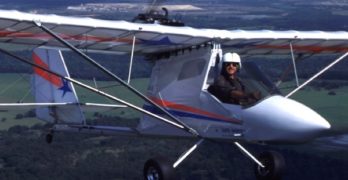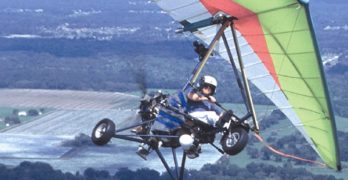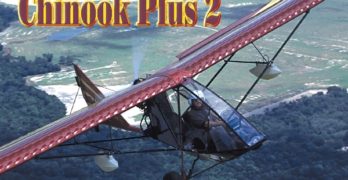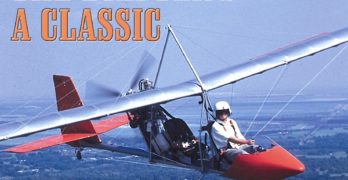Thousands of other Phantom ultralights are flying, but the one I was about to fly was built by a bunch of kids. Although they were no doubt serious and focused during the building effort, the Phantom X-1 was named Child’s Play. Had I lost my mind?
“So, you’re really going to fly that ultralight built by a bunch of elementary school kids, huh?” The question was more than small talk. The prospect actually worried some observers.
“Of course,” I replied. “The kids probably did a better job than I could.” I’m no builder, a fact I often repeat. After flying airplanes built by all kinds of pilots, I didn’t see the jeopardy in flying the product of students at the Haverhill Elementary School in Portage, Michigan.1
I admit I looked over the Phantom carefully, but I found no flaws. Besides, long-time Phantom pilot and Phantom Aircraft Company president Pat Schultheis had already test-flown it and put hours on it.
Search Results for : CT AND hand control
Not finding exactly what you expected? Try our advanced search option.
Select a manufacturer to go straight to all our content about that manufacturer.
Select an aircraft model to go straight to all our content about that model.
Phantom X-1E
What would you do if you produced one of the best known and best loved classic ultralights in the world? If your name is Pat Schultheis and your brand is Phantom, you probably wouldn’t mess with success.
Known simply as Phantom to most folks, the proper name is actually the Phantom X-1. Even this model has gone through refinements over the years. And some builders have further varied the theme; one Phantom I flew had been converted to a taildragger – it was a blast.
A 2-seat Phantom model was tried years ago and newer efforts are underway at this time. The first effort, under the direction of then-Phantom company owner Jack Taylor, flopped so badly that after a short, challenging flight in the machine, I gave it back to the factory and told them I couldn’t report on it yet; it simply wasn’t right and shouldn’t be sold to customers.
Drifter SB
One-time Aussie distributor Chris Blackwell claimed sales in excess of 200 units – and this was the American-produced version from the Maxair company. It proved no impediment that Drifter kits had to be shipped halfway around the Earth to reach the land of kangaroos.
Sometime after this illustrious and energetic time, things went south for Maxair in more than just a financial way. Through a labyrinth of twists and turns, a Florida man named Don Jones ended up owning the one-time Pennsylvania company in a set of circumstances most charitably called “questionable.” At best, he kept the design alive. At worst, he sunk the design into near oblivion.
Fortunately, good things tend to stick around, regardless of how badly they’re treated. The Drifter is an example.
Perhaps because the Drifter made it to Australia in large numbers, the ’97 incarnation of the tandem aircraft now returns from the country on the bottom side of the globe.
Quicksilver’s GT 400
The GT 400 isn’t the fastest handling ultralight, nor is it the speediest, cheapest, most modern, nor fastest to build. But it does everything so well it doesn’t need to be tops at any one function. In this sense, I believe the GT 400 may be the best ultralight in the world.
While “best” means something different for virtually every pilot, I’ll go out on a limb and predict that any pilot who flies the GT 400 will find it a highly satisfying ultralight.
Fortunately for other ultralight manufacturers, every single pilot is different, a unique individual.
Still, for an estimated 1,000 current GT 400 owners – and the new buyers that will follow – the GT 400 single-seater that Quicksilver first offered in 1984 remains an excellent choice.
If you accept my opinion that the 400 is a desirable ultralight, then you may be moved to action by its pricing.
Quicksilver’s Sport II S
Think about the Cessna 172, workhorse of general aviation and the most popular aircraft ever built. Cessna is once again building them though the plane has seen little change other than new interior finishings and avionics.
Published in Light Sport and Ultralight Flying
Empty weight
430 pounds
Gross weight
1,000 pounds
Wingspan
31 feet 2 inches
Wing area
170 square feet
Wing loading
6.1 pounds per square foot
Length
18 feet
Height
8 feet
Kit type
Assembly-type bolt-together)
Build time
50-75 hours
Standard engine
Rotax 582 2-cycle
Power
65 hp at 6,500 rpm
Power loading
15.4 lbs/hp
Cruise speed
(75% power) 64 mph
Never exceed speed
80 mph
Rate of climb at gross
850 feet per minute
Takeoff distance at gross
325 feet
Landing distance at gross
125 feet
Standard Features
Rotax 582 engine, ASI, full dual controls with dual rudder pedals and steerable nosewheel, dual throttles, mechanical brakes, in-flight adjustable trim, 4-point seat belts, double-surface presewn wings, 2-blade wood prop, extensive manuals.
Quicksilver’s Sport II
You’ve heard it before: Quicksilver is back! Again and again we’ve heard this, yet it seemed to be an apparition, a mirage in the desert. As soon as you thought the company had put its financial affairs in order, along came another disappointing tale of what was politely called “corporate restructuring.”
In fact, the changes were often more provocative than substantial, but they gave the impression of a company that had lost its way. The worst thing that happened was that customers became unsure if they should send deposit money.
This was not a good place to be in the ultralight industry. Companies work hard to establish good reputations. They know those good vibes can disappear as quickly as a wing nut in tall grass.
The 1999 reincarnation of the company is called Quicksilver Manufacturing. Previously, the company had been called Quicksilver Enterprises and Quicksilver Aircraft (and before that a series of Eipper iterations, named after founder Dick Eipper).
Talon Super Magnum
Among the aircraft produced by Sport Flight Aviation are the tandem 2-seat Talon XP, the Talon Magnum single-seater, and our plane for this test, the single-seat Talon Super Magnum. The energized version comes from the substantial 80-hp twin-cylinder 4-stroke engine that pushes the single-seater aloft with an enthusiasm that is truly inspirational.
Published in Light Sport and Ultralight Flying
Seating
Single-seat
Empty weight
494 pounds
Gross weight
1,056 pounds
Wingspan
29 feet 6 inches
Wing area
156 square feet
Wing loading
6.8 pounds/sq ft
Length
21 feet 9 inches
Height
6 feet 4 inches
Fuel Capacity
10 gallons
Kit type
Assembly
Build time
130-150 hours
Standard engine
Verner SVS-1400 4-cycle
Power
80 hp at 5,000 rpm
Power loading
13.2 pounds/hp
Cruise speed
76 mph at 3,900 rpm
Never exceed speed
110 mph
Rate of climb at gross
1,000 fpm
Takeoff distance at gross
170-200 feet
Landing distance at gross
300 feet
Standard Features
3-position flaps, rudder trim, steerable tailwheel with takeoff/landing lockout, 4130 chromoly steel landing gear, streamlined struts, windscreen, nose fairing, instrument panel, 4-point shoulder harness pilot restraint, aluminum wheels, padded seat, cargo area.
Aerotrike
Until recently, we heard little from South Africa. Under the country’s apartheid (racial segregation) rule of the past, South Africa disappeared off the radar so far as most Yankee pilots knew. Our government instituted economic sanctions so that few, if any, South African products appeared in America.
Apartheid is over, and with it the isolation of that southern hemisphere country and its people. In recent years, we’ve seen a growing number of products arrive from the way down under country. Perhaps you’re not surprised to hear that South African ultralight builders are also making a mark on American aviation. Welcome to the modern age of globalization.
No Pushy Peddler
You probably already know of Rob Rollison. He garnered attention in April ’95 by flying his Air-Bike from Indiana to Lakeland, Florida.1 The trip set no records – Ian Coristine, Dave Goulet and Don Zank flew 2-seat Challengers 2,400 miles (round trip) from Moline, Illinois to Lakeland a decade earlier – but in an open-cockpit ultralight, no doubt Rob’s 870-mile (each way) flight seemed longer.
Chinook Plus 2
What started as Canadian Ultralight Manufacturing has now become ASAP and Brent Holomis is now president again. In the early days of the Vernon, British Columbia company, Brent became occupied with GSC props and focused on building that enterprise while brother Curt dealt with aircraft sales. Now they’re both involved in aircraft manufacturing.
Expanding Enterprise
Over the years, ASAP’s business has expanded and the western Canada company now sells the Chinook Plus 2 and the Beaver RX-550 Plus, tagging both models with the “plus” suffix that indicates the ASAP team improved and refined the aircraft after their acquisition of the models.
I find it impressive that two of Canada’s most popular ultralights are now built by ASAP, a company that rescued these designs after the original companies failed. Birdman Enterprises designed and built the Chinook, and Spectrum Aircraft built the Beaver RX-550 (though the latter company went through a few name/ownership changes before succumbing completely).
Super Drifter
The original Drifter was one of the ultralight industry’s flagship aircraft. Hatched by early entrepreneur Dennis Franklin, the Maxair Drifter enjoyed immense popularity. Several reasons exist for the Drifter’s popularity, and these were enough for Leza-Lockwood to offer a rebirth to the design.
Déjà Vu All Over Again
The Drifter is a tough design. The basic airframe consists of a lower boom tube that supports the pilot at the front and the large empennage at the rear with an engine midship. Because the separation is longer than some similar designs, the Drifter boasts a high level of stability that should please most pilots.
Secured to the boom by a series of triangulated tubing structures, the wing is classic Klaus Hill. This prolific designer from the early ’80s died in an unfortunate accident many years ago, but not before putting his indelible mark all over ultralight aviation. Klaus is directly responsible for the wings of the Weedhopper, Hummer, Humbug and SuperFloater.
- « Previous Page
- 1
- …
- 56
- 57
- 58
- 59
- 60
- …
- 62
- Next Page »


